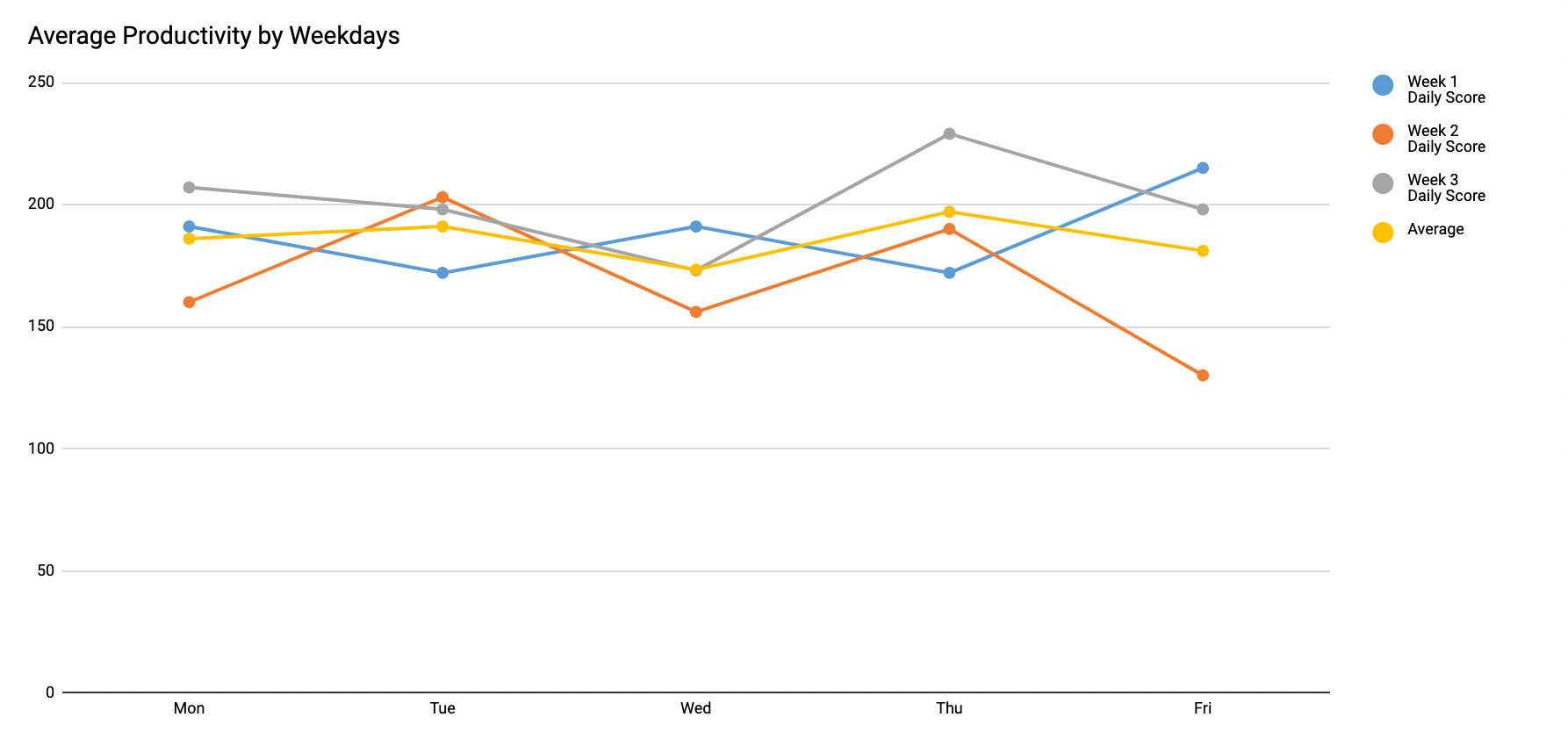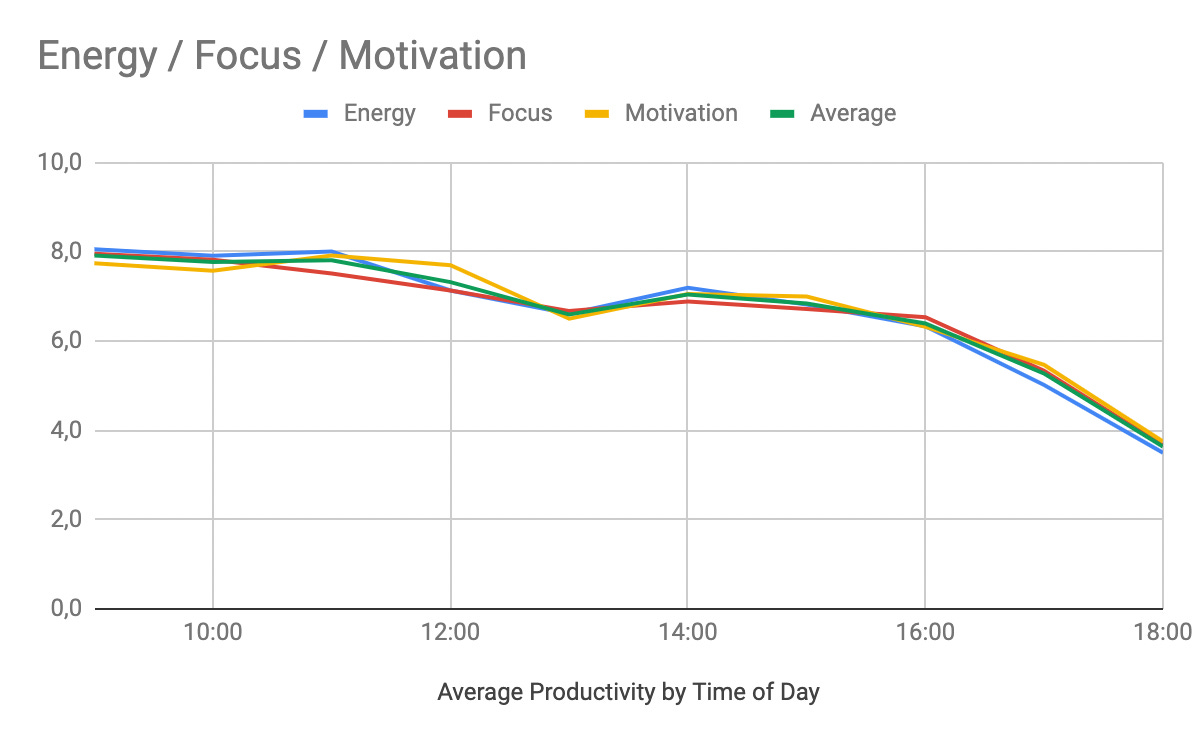10X Productivity by capitalizing on your Circadian Rhythm. How? Try this method. (Free resource included)
Some of us are morning larks, some are night owls. How does this impact your productivity, and how can you test this? Here's a tool to track your own data, and then make improvements based on it.

Morning person, evening person, afternoon person. Which one are you?
You’ll have an intuitive answer to this. I, for example, am definitely a morning person, and rather useless anytime after 5pm.
Thursdays are also by far more productive than any other day of the week.
How is this possible?
It all has to do with our circadian rhythm (and the way we design our workdays).
#1 - Circadian Rhythm Explainer
The Circadian Rhythm is our natural body cycle that lasts roughly 24 hours. It’s what gets us up in the morning, and makes us sleepy at night. Every person’s circadian rhythm is slightly different - some are morning larks, some are night owls, some are in between (like my ex-girlfriend who was/is a self-proclaimed “afternoon person”). These types are called “Chronotypes”, and explain when you’re most alert.
Your chronotype determines when you’re sleepy and when you’re not.
But how do these relate to productivity?
Morning larks work better in the morning and night owls better at night. Nothing too crazy here. But there are deviations in the meantime - and identifying your most productive hours goes a long way to being a more effective person.
How do you find out what works best for you?
#2 - Intuition vs Data
You could use your intuition. But you’ll have a lot of biases, and might draw the wrong conclusions.
You could also use data. That’s probably more accurate.
Which is what we’ll do.
For the next three weeks, I want you to run an experiment. Every hour on the dot (during the workday), jot down on a scale from 1 (low) to 10 (high) how energetic, focused, and motivated you feel. You don’t have to justify how you feel. Just take your gut feeling and note down how you feel.
After three weeks, you’ll have a surprisingly clear idea when you’re most productive.
I did this in the past three weeks. Here’s my data:


As you can see, I’m most productive in the mornings. No surprises here.
You can also see a slight dip around lunchtime, which is perfectly normal for most people (at least if you eat lunch and your body has to digest afterward). To be honest, I would’ve expected this dip to be bigger - but the data said otherwise.
Also, I would’ve expected a slight uptick around 5pm, which is what I had when I last did this experiment six years ago. However, after 4pm it’s just straight downhill.
You can also see that my most productive days are Thursdays.
Interesting. Here are the adjustments that I made or will make based on these insights.
(Want to try this yourself? Keep reading - I have a spreadsheet template for you at the bottom).
#3 - What to do with this information
Now, you know when you’re more and less focused during the day. What do you do with this information?
Here are a few things:
- Block out your most productive hours on your calendar. For example, I try not to have any meetings before 10am, giving me 60-120 minutes to work deeply on the most important topics on my plate.
- I also don’t take any meetings after 5pm. My energy is low then already, and the only thing I should be working on at that time is wrapping up the day, and making sure I set myself up for success the next day.
- During the lowest productivity hours, it’s great time to step away from “brain-work” and do something physical instead. I like to lift weights around lunchtime or after work, where mental energy is lower. Sports give me energy, so I can get extra action in once I’m back. Don’t train so hard that you’re tired after. Save that for evenings or weekends.
- On the note of training: above, I mentioned that I didn’t see the lunchtime dip that I had expected. I ran the same experiment six years ago, and the lunchtime dip was much bigger. One big adjustment I made is that I regularly lifted weights around lunchtime, thus alleviating that dip completely.
- You can also consume caffeine strategically to give you extra boost across your low-productivity hours. Read more on usage of caffeine in International Generalist #1.
- I’m more productive on Thursdays because they are the only days on which I block a 3+ time window to do deep work. This boosts productivity like crazy and I wonder why I don’t do it more often.
The main takeaway:
Use the times on which you’re productive to work on your top goal. For me, that’s everything before lunchtime, with peaks between 8 and 11am. If you can capitalise on these hours, your productivity is going to skyrocket.
#4 - What if I’m an evening person?
We’ve all read that successful people get up super early in the morning. Are they successful because they get up early? Or is our world simply designed in a way that’s advantageous for morning persons, and they happen to be one?
I believe it’s the latter. There’s no point in forcing yourself to get up and be productive in the day early if your prime hours are in the evening. Rather capitalize on those, and catch up on sleep in the morning.
My co-founder Matthias, for example, used to start work at 10am and then would work until 8 or 9pm usually, whereas I’d start at 8:30 and finish at 18:00 (and probably should’ve finished at 17:00).
There is no shame in starting late if that fits your chronotype better. Just be sure to communicate that, and doing an experiment like this one will certainly help you argue for that.
Remote work and geographic distribution make it easier and easier to adhere to your own rhythm instead of forcing yourself to be someone you’re not.
#5 - The afternoon dip
After lunch, focus dips for most people. Our bodies are busy digesting, we’ve been awake for ~7 hours, the attention just isn’t there anymore and coffee cannot solve it either. Besides sports, a few other things have worked well for me to fight the afternoon dip:
- Eating a light meal for lunch, and going heavy breakfast and dinner. You need to get your calories in, but maybe lunch isn’t the right time. Depending on your calorie needs, it might make more sense to have 2 lighter meals at noon and 3pm (this is what I do sometimes, but I also burn >3.000kcal per day).
- Taking a 20-30 min nap. Generally a good practice (more sleep > less sleep), but often inconvenient (unless you have an office where napping is possible and socially accepted). Afterwards, I feel super refreshed. At least as long as I get up INSTANTLY once my alarm goes off.
- Following the Slow-Carb-Diet. I had no idea this works until I tried it, but when following the slow-carb diet, I never experienced even a slight afternoon dip, not even after having eaten a large lunch. Don’t ask me how the physiology works here, but that felt great.
- Oh, and obviously coffee. But make sure to drink it as soon as possible after lunch to not screw with your sleep.
#6 - Setting your Circadian Rhythm
You will stick to your productivity times best when following your natural circadian rhythm. Which means roughly getting up at the same time every day, and going to sleep around the same time every day.
You can set your internal clock by manipulating the light around you:
- First thing in the morning, get exposure to sunlight (Dr. Andrew Huberman keeps hammering home this point over and over again), ideally in your eyes. If there’s no sunlight, a daylight lamp / lamp high in blue light will do.
- During the day, spend 10-30m outside, and again get light exposure. Doesn’t matter if it’s overcast, getting some sunlight onto yourself is great. Commutes, eating lunch outside of your (home) office, and walks are great for this.
- At night, turn down bright lights. I try to only use candlelight at night (shoutout to my wonderful girlfriend for this adjustment), and it makes me really sleepy. Oh, and of course, no screens, but we all know that yet it’s super hard to adhere to.
#7 - The Experiment
And now, it’s your turn.
This experiment is low-friction, high reward.
I’ve prepared a spreadsheet for you (absolutely free). Just copy or download it, and use it for your own purposes.
Pro tips:
- Use a timer or similar to remind yourself to log your numbers every hour.
- I set reminders in my work Slack using the /remind command (/remind me every weekday at 8:00 to log my energy/focus/motivation). Unfortunately, you have to set one for every hour, but this takes about 5min to set up.
Again, the spreadsheet (incl. instructions!) is here.
And if you liked this post, make sure to share it & subscribe to stay on top of things.
Thank you.
Dominik Nitsch Newsletter
Join the newsletter to receive the latest updates in your inbox.


